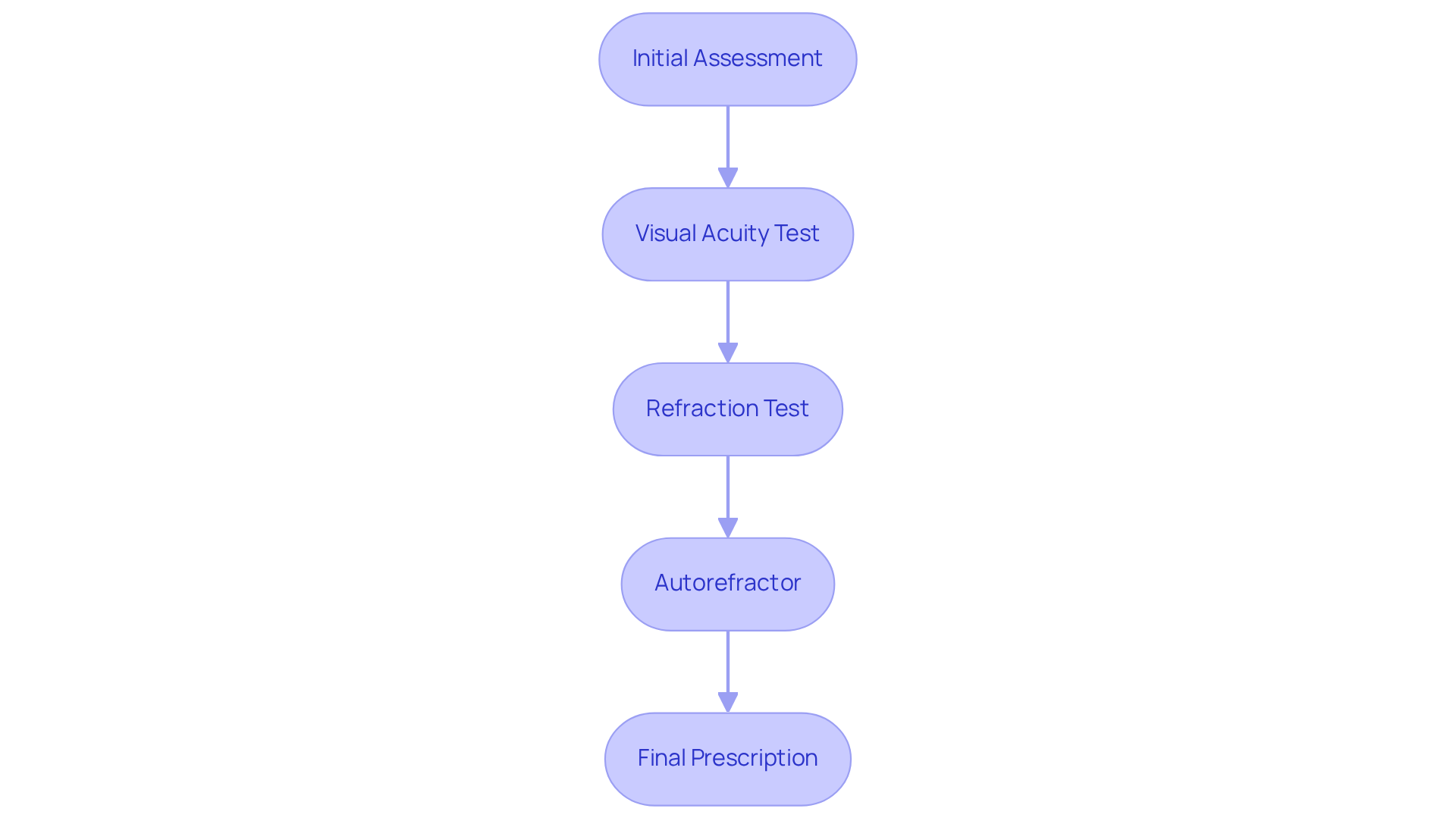Posted by: Northwest Eye in General on November 5, 2025
Overview
Understanding refraction is crucial for cataract patients. We know that navigating vision changes can be overwhelming, and this aspect plays a significant role in your clarity of sight. Accurate refraction assessments are essential; they can prevent residual errors after surgery and enhance your visual outcomes.
It’s common to feel uncertain about the best treatment options. That’s why personalized lens selection is so important. We want to ensure that your unique needs are met, and thorough follow-up care is vital in this journey.
By focusing on these elements, we can help you achieve the best possible vision. Remember, you’re not alone in this process. We are here to help you through every step, providing the support and information you need to feel confident in your choices.
Introduction
Understanding how light bends in the eye is essential for anyone facing cataract surgery. We know that this can be a daunting experience, and many patients worry about how their vision will be affected afterward. This article aims to shed light on the mechanics of eye refraction, the refractive errors that may occur, and the important tests that help guide treatment decisions.
It’s common to feel uncertain about what to expect post-surgery. By exploring the connection between refraction and visual clarity, you’ll gain valuable insights that can help you make informed choices about your eye care journey. Remember, you’re not alone in this process; we are here to help you through it.
As you read on, you’ll discover key information that can reassure you about your vision outcomes. We understand that every step can feel overwhelming, but with the right knowledge, you can approach your surgery with confidence.
Define Eye Refraction and Its Role in Vision
Refraction eye refers to the bending of light rays as they pass through the eye’s cornea and lens, allowing us to focus on objects at different distances. When light enters the refraction eye, it is refracted to converge on the retina, where it transforms into visual signals sent to the brain. We understand that proper refraction eye is essential for sharp sight; any irregularities can lead to refractive errors, which are common in individuals with lens opacity. Recognizing this process helps you appreciate the importance of precise refraction eye evaluations during eye exams, particularly when considering surgical options like lens replacement that can restore or enhance your sight.
At Northwest Eye, we prioritize personalized lens selection to optimize your visual outcomes. Our lens specialists work closely with you to identify the best lens choices tailored to your lifestyle and visual needs. The Innovative Light Adjustable Lens (LAL) Package allows for personalized sight correction after cataract surgery, giving you the chance to test your desired focal point adjustments before finalizing your prescription. This adaptable approach ensures that you can achieve the best vision customized to your unique situation.
Moreover, the role of corneal power is crucial in optimizing outcomes for the refraction eye. We understand that keratometric errors can significantly impact post-operative refraction eye, leading to unexpected visual results. Accurate axial length measurement is also vital; even a small error in the refraction eye can lead to substantial refractive surprises, affecting your overall satisfaction with surgical outcomes.
Statistics show that many individuals experience residual refractive errors after surgery, highlighting the importance of follow-up care. For instance, between 1992 and 2006, studies indicated that 72.3-87.0% of individuals experienced a shift from the target refraction of ±1.0 D following lens surgery. This underscores the need for open conversations with your eye care professionals about how refraction eye affects your treatment choices and results.
In summary, understanding refraction eye not only helps you recognize the significance of routine eye examinations but also empowers cataract patients to make informed decisions about their eye care, ultimately enhancing their quality of life. We are here to help you through this process.

Explore Types of Refractive Errors and Their Symptoms
Refractive errors can be concerning, and it’s important to understand the different types of refraction eye issues that may affect your vision. Here’s a closer look at the four primary types:
-
Myopia (Nearsightedness): If you find it hard to see distant objects clearly, you might be experiencing myopia. This condition often leads to squinting and eye strain, which can be quite uncomfortable. Many people report headaches and fatigue during activities that require distance sight. We understand how frustrating this can be.
-
Hyperopia (Farsightedness): On the other hand, if focusing on close objects is a struggle, you may have hyperopia. This can cause eye strain and discomfort, especially during tasks like reading or sewing. Symptoms often include headaches and a sense of fatigue after prolonged near work. It’s common to feel overwhelmed by these challenges.
-
Astigmatism: Astigmatism is a prevalent refractive issue affecting the refraction eye, which can result in unclear vision at all distances due to an irregularly shaped cornea or lens. Many patients experience visual disturbances, such as glare and halos around lights, particularly at night. Research indicates that individuals with astigmatism may face greater difficulties with night-time driving and could make more mistakes in sight-related tasks compared to those with corrected eyesight. We know how important clear vision is for your daily activities.
-
Presbyopia: Typically affecting those over 40, presbyopia is characterized by age-related difficulty in focusing on near objects. You might find yourself holding reading materials at arm’s length or relying more on reading glasses. It’s a common experience, and you’re not alone in this.
Recognizing these signs is crucial, especially when considering lens surgery, as they may indicate underlying refraction eye issues that need attention. Regular eye exams are essential for monitoring these conditions and ensuring your vision health remains optimal. Remember, we are here to help you through this process and support you in achieving the best vision possible.

Detail the Refraction Testing Process and Equipment Used
The refraction eye testing process for cataract patients involves several key steps that ensure accurate assessment and optimal treatment outcomes. We understand that this can be a daunting experience, so let’s walk through it together:
-
Initial Assessment: Your eye care professional will start by gathering your medical history and discussing any symptoms you may be experiencing. It’s important to share your feelings and concerns during this time.
-
Visual Acuity Test: You’ll be asked to read letters from an eye chart. This helps establish your baseline eyesight and gives us a clearer picture of your needs.
-
Refraction Test: Using a phoropter, the doctor will present various lens combinations to find the option that offers you the sharpest sight. You’ll participate by comparing choices, often responding with ‘better one or better two?’. This is a collaborative process, and your input is invaluable.
-
Autorefractor: This automated device measures how light is focused in your eye, providing an initial estimate of the necessary prescription. It’s a quick and painless step that helps us understand your vision better.
-
Final Prescription: After analyzing the results, your eye care professional will provide a prescription for glasses or contacts, or discuss potential surgical options. We’re here to ensure you feel confident in your choices.
Understanding this process is crucial for cataract patients, as it directly impacts your treatment decisions and overall eye health. The devices utilized, especially the phoropter and autorefractor, serve a vital function in guaranteeing accurate measurements. This ultimately leads to improved sight correction and management, helping you see the world more clearly.
Remember, we are here to help you through this process, and it’s common to feel a mix of emotions. Your comfort and clarity are our top priorities.

Discuss Treatment Options Based on Refraction Results
Based on the results of your refraction eye test, we understand that you may have questions about your treatment options. Here are several recommendations that could help you see more clearly:
-
Eyeglasses: These are the most common solution for correcting refractive errors. Tailored to your specific needs identified during testing, eyeglasses utilize refraction eye principles to efficiently refract light and enhance your sight. They can accommodate various conditions such as myopia, hyperopia, and astigmatism, providing you with a reliable way to improve your vision.
-
Contact Lenses: If you prefer a substitute for spectacles, contact lenses might be the right choice for you. They offer a broader scope and enhanced convenience, sitting directly on the eye’s surface. This allows for a more natural perspective without frames obstructing your peripheral sight.
-
Refractive Surgery: Refractive surgery procedures, such as LASIK and PRK, can permanently correct refractive errors by reshaping the cornea. LASIK involves creating a thin flap in the cornea, while PRK removes the outer layer of corneal cells. Many individuals have achieved 20/20 eyesight after these surgeries, and financing options, including 0% interest financing through CareCredit for up to 24 months, can make these procedures more accessible.
-
Cataract Surgery: If you have cataracts, surgery can eliminate the cloudy lens and also correct refractive errors. This is done by implanting intraocular lenses (IOLs) tailored to your optical requirements. Advances in IOL technology, like the Light Adjustable Lens (LAL), allow for postoperative adjustments to enhance your visual results. Studies show that 90% of patients achieve 20/20 sight without corrective eyewear after receiving the LAL, and those with LAL were twice as likely to reach this clarity compared to those with a standard monofocal lens implant. Affordable financing options, including low-interest plans for up to 60 months, are available for cataract surgery and premium IOLs.
-
Post-operative Care: After any surgical intervention, ongoing monitoring and adjustments may be necessary to ensure optimal vision outcomes. Regular follow-ups with your eye care provider are crucial for assessing recovery and making any needed corrections. We understand that discussing potential risks and side effects associated with each treatment option is important for your peace of mind, so please feel free to ask questions.
Understanding these options empowers you to engage actively in your treatment planning. We are here to help you through this process and support you in making informed choices about your eye health.

Conclusion
Understanding the complexities of eye refraction is essential for cataract patients. It directly affects their visual outcomes and overall quality of life. We recognize that grasping how light bends as it travels through the eye’s structures is crucial for understanding how refractive errors can impact vision. This knowledge empowers patients to make informed decisions about their eye care and treatment options.
In this article, we explore various types of refractive errors, including:
- Myopia
- Hyperopia
- Astigmatism
- Presbyopia
Each comes with specific symptoms that can disrupt daily activities. We emphasize the importance of thorough refraction testing, which uses specialized equipment to ensure accurate assessments. This accuracy is vital for guiding effective treatment choices. Additionally, we highlight the significance of personalized lens selection and attentive post-operative care in achieving the best visual results after cataract surgery.
Ultimately, the insights shared here underscore the necessity of regular eye examinations and open communication with eye care professionals. We understand that navigating this journey can feel overwhelming, but by actively engaging in the treatment planning process and grasping the role of refraction in vision, cataract patients can enhance their sight and enjoy a better quality of life. Taking proactive steps in eye health is essential, and we encourage individuals to seek assistance and information to guide them toward clearer vision.
Frequently Asked Questions
What is eye refraction?
Eye refraction refers to the bending of light rays as they pass through the eye’s cornea and lens, allowing us to focus on objects at different distances.
Why is proper eye refraction important?
Proper eye refraction is essential for sharp sight; any irregularities can lead to refractive errors, which are common in individuals with lens opacity.
How does eye refraction relate to visual signals?
When light enters the eye, it is refracted to converge on the retina, where it transforms into visual signals that are sent to the brain.
What role do lens specialists play at Northwest Eye?
Lens specialists at Northwest Eye work closely with patients to identify the best lens choices tailored to their lifestyle and visual needs.
What is the Innovative Light Adjustable Lens (LAL) Package?
The Innovative Light Adjustable Lens (LAL) Package allows for personalized sight correction after cataract surgery, enabling patients to test their desired focal point adjustments before finalizing their prescription.
How does corneal power affect eye refraction outcomes?
Corneal power is crucial in optimizing outcomes for eye refraction; keratometric errors can significantly impact post-operative results.
Why is accurate axial length measurement important?
Accurate axial length measurement is vital because even a small error in eye refraction can lead to substantial refractive surprises, affecting overall satisfaction with surgical outcomes.
What do statistics indicate about residual refractive errors after surgery?
Statistics show that many individuals experience residual refractive errors after surgery, with studies indicating that 72.3-87.0% experienced a shift from the target refraction of ±1.0 D following lens surgery between 1992 and 2006.
How can patients enhance their quality of life regarding eye care?
Understanding eye refraction helps patients recognize the significance of routine eye examinations and empowers cataract patients to make informed decisions about their eye care, ultimately enhancing their quality of life.






